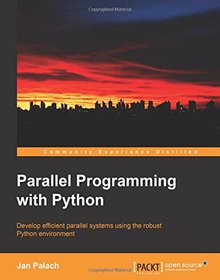Parallel Programming with Python

Book Details:
| Publisher: | Packt Publishing |
| Series: | Packt |
| Author: | Jan Palach |
| Edition: | 1 |
| ISBN-10: | 1783288396 |
| ISBN-13: | 9781783288397 |
| Pages: | 107 |
| Published: | Jun 25 2014 |
| Posted: | Nov 19 2014 |
| Language: | English |
| Book format: | |
| Book size: | 2.02 MB |
Book Description:
Develop efficient parallel systems using the robust Python environment Overview Demonstrates the concepts of Python parallel programming Boosts your Python computing capabilities Contains easy-to-understand explanations and plenty of examples In Detail Starting with the basics of parallel programming, you will proceed to learn about how to build parallel algorithms and their implementation. You will then gain the expertise to evaluate problem domains, identify if a particular problem can be parallelized, and how to use the Threading and Multiprocessor modules in Python. The Python Parallel (PP) module, which is another mechanism for parallel programming, is covered in depth to help you optimize the usage of PP. You will also delve into using Celery to perform distributed tasks efficiently and easily. Furthermore, you will learn about asynchronous I/O using the asyncio module. Finally, by the end of this book you will acquire an in-depth understanding about what the Python language has to offer in terms of built-in and external modules for an effective implementation of Parallel Programming. This is a definitive guide that will teach you everything you need to know to develop and maintain high-performance parallel computing systems using the feature-rich Python. What you will learn from this book Explore techniques to parallelize problems Integrate the Parallel Python module to implement Python code Execute parallel solutions on simple problems Achieve communication between processes using Pipe and Queue Use Celery Distributed Task Queue Implement asynchronous I/O using the Python asyncio module Create thread-safe structures Approach A fast, easy-to-follow and clear tutorial to help you develop Parallel computing systems using Python. Along with explaining the fundamentals, the book will also introduce you to slightly advanced concepts and will help you in implementing these techniques in the real world. Who this book is written for If you are an experienced Python programmer and are willing to utilize the available computing resources by parallelizing applications in a simple way, then this book is for you. You are required to have a basic knowledge of Python development to get the most of this book.
Download Link:
Related Books:
Parallel Programming
With Intel Parallel Studio XE
Optimize code for multi-core processors with Intel's Parallel StudioParallel programming is rapidly becoming a "must-know" skill for developers. Yet, where to start? This teach-yourself tutorial is an ideal starting point for developers who already know Windows C and C++ and are eager to add parallelism to their code. With a focus on applying tools, techniques, and language extensions to implement parallelism, this essential resource teaches you how to write programs for multicore and leverage the power of multicore in your programs. Sharing hands-on case studies and real-world examples, the authors examine the challenges of each project and show you how to overcome them.Explores conversion of serial code to parallelFocuses on implementing ...
Parallel Programming with Microsoft Visual C++
Design Patterns for Decomposition and Coordination on Multicore Architectures
Your CPU meter shows a problem. One core is running at 100 percent, but all the other cores are idle. Your application is CPU-bound, but you are using only a fraction of the computing power of your multicore system. Is there a way to get better performance? The answer, in a nutshell, is parallel programming. Where you once would have written the kind of sequential code that is familiar to all programmers, you now find that this no longer meets your performance goals. To use your system's CPU resources efficiently, you need to split your application into pieces that can run at the same time. Of course, this is easier said than done. Parallel programming has a reputation for being the domain of experts and a minefield of subtle, hard-to-reproduce softw...
Parallel Programming with Microsoft Visual Studio 2010 Step by Step
Your hands-on, step-by-step guide to the fundamentals of parallel programming Teach yourself how to help improve application performance by using parallel programming techniques in Visual Studio 2010-one step at a time. Ideal for experienced programmers with little or no parallel programming experience, this tutorial provides practical, learn-by-doing exercises for creating applications that optimize the use of multicore processors. Discover how to: Apply techniques to help increase your application's speed and efficiency Simplify the process of adding parallelism with the Task Parallel Library (TPL) Execute several tasks concurrently with various scheduling techniques Perform data queries in parallel with PLINQ Use concurrent collections in Microsof...
2007 - 2021 © eBooks-IT.org



